 We were up quite early yesterday. Although our itinerary started with breakfast at 7 a.m., Karlo and I got up at 5 a.m. to check out the provincial capitol of Cagayan and take photos for possible inclusion in the 2007 HCS calendar.
We were up quite early yesterday. Although our itinerary started with breakfast at 7 a.m., Karlo and I got up at 5 a.m. to check out the provincial capitol of Cagayan and take photos for possible inclusion in the 2007 HCS calendar.One thing which surprised me was its distance from the town center since the tricycle ride took about ten minutes. It was actually at the border of Tuguegarao and Peñablanca and in the middle of nowhere. In fact, you first had to cross the welcome arch of Peñablanca to get to it. From the gates, we could already see that we were not going to be disappointed.
The capitol building may be the last untouched piece of heritage in Tuguegarao. It is in the center of a gated compound that is very well-maintained. In front of it is a large landscaped lawn which contains a relief map of Cagayan and an old fountain among others.
 After taking photos, we went back to the hotel for breakfast. The group left the hotel at 8 p.m. for visits to the Cagayan towns further up north. First on the list was the town of Iguig which was famous for its Calvary Hills, a collection of life-sized tableaus of the Stations of the Cross scattered across the sprawling grounds of the church.
After taking photos, we went back to the hotel for breakfast. The group left the hotel at 8 p.m. for visits to the Cagayan towns further up north. First on the list was the town of Iguig which was famous for its Calvary Hills, a collection of life-sized tableaus of the Stations of the Cross scattered across the sprawling grounds of the church.Sad to say, the façade of this old church was badly-altered. But the sides remained relatively intact. What is unique about this church are the “flying buttresses” found at the back of the church which are the only one of its kind in the country. I hope the priests realize that and do not touch it.
 From Iguig, we proceeded to Alcala where an unpleasant surprise greeted us. In front of the red brick church was a billboard showing a modern interior in the works. Damage had already been done to the interior. The original wooden ceiling had already been replaced by galvanized iron sheets. You could also see that there were elements such as a choirloft which had already been demolished.
From Iguig, we proceeded to Alcala where an unpleasant surprise greeted us. In front of the red brick church was a billboard showing a modern interior in the works. Damage had already been done to the interior. The original wooden ceiling had already been replaced by galvanized iron sheets. You could also see that there were elements such as a choirloft which had already been demolished.I immediately looked for the parish priest to talk to him before more damage was done. In fairness, the priest was quite receptive. He said they had been trying to contact the National Commission for Culture and the Arts for help but to no avail.
 Now we see an oversight on the part of the government. The stakeholders do not have a direct line to the technical support that they need. I think it’s about time that the NCCA reaches out to these stakeholders by simply writing all custodians of heritage churches all over the country to let them know that technical assistance is available if you contact the NCCA, National Museum or National Historical Institute; and that they could get advice from the experts before they make any plans to renovate or restore a church. Writing letters to everyone to let them know that they're there to help is the least they could do.
Now we see an oversight on the part of the government. The stakeholders do not have a direct line to the technical support that they need. I think it’s about time that the NCCA reaches out to these stakeholders by simply writing all custodians of heritage churches all over the country to let them know that technical assistance is available if you contact the NCCA, National Museum or National Historical Institute; and that they could get advice from the experts before they make any plans to renovate or restore a church. Writing letters to everyone to let them know that they're there to help is the least they could do.You could also see that the priests lacked basic knowledge of what restoration was. The parish priest mentioned to us that the proposed altar design was done by another priest who was also into restoration. But obviously, the altar was not restoration. It was a modern replacement that did not match the age of the church. Priests really have to be educated, especially those who make these designs and claim that they are restorations.
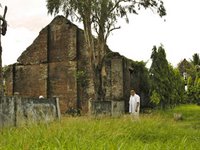 Our next stop was the town of Gattaran. But we weren’t going to the town church which was equally quaint. If only we weren’t pressed for time, I would have wanted to stop at the town church as well. Instead, we visited the Nassiping Church ruins which was the church of Nassiping town before it was merged with Gattaran.
Our next stop was the town of Gattaran. But we weren’t going to the town church which was equally quaint. If only we weren’t pressed for time, I would have wanted to stop at the town church as well. Instead, we visited the Nassiping Church ruins which was the church of Nassiping town before it was merged with Gattaran.The stone side altars were quite intact. But a sad note was one of its bells was stolen last year, most probably by an antique dealer. I wish stealing these relics could be considered a heinous crime! These unscrupulous antique dealers should be shot by the towsfolk if they are caught carting away priceless pieces of heritage, to teach them a lesson. Check out the article in the PDI.
Our next stop was the town of Lal-lo which was also known as Nueva Segovia. It was the former seat of the Diocese of Nueva Segovia before it was transferred to Vigan in 1758. The story of the transfer is in the Vigan website.
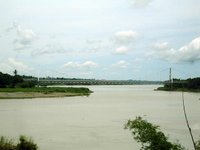 But before visiting the old church, we passed by the Magapit Suspension Bridge which spans the Cagayan River. It was one of the most modern in Asia during its time. Another monumental Marcos project which lessened the travel time between Cagayan and Ilocos, it shows us how much Philippine infrastructure has deteriorated today. The DPWH should let architects and not engineers design bridges. That's if they want to rid themselves of the reputation of churning out the ugliest infrastructure in the world! The only recently constructed bridge worth praising is the Bamban Bridge linking Mabalacat and Bamban. But then again, that was a Japanese financed project. Hehe!
But before visiting the old church, we passed by the Magapit Suspension Bridge which spans the Cagayan River. It was one of the most modern in Asia during its time. Another monumental Marcos project which lessened the travel time between Cagayan and Ilocos, it shows us how much Philippine infrastructure has deteriorated today. The DPWH should let architects and not engineers design bridges. That's if they want to rid themselves of the reputation of churning out the ugliest infrastructure in the world! The only recently constructed bridge worth praising is the Bamban Bridge linking Mabalacat and Bamban. But then again, that was a Japanese financed project. Hehe!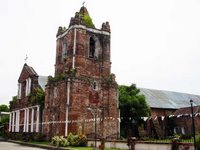 Anyway, the facade of the Lal-lo Church was similar to that of Alcala. In front of the church was an wooden cross encased in glass. According to the marker, it was planted there over 300 years ago by the Dominican missionaries who evangelized Cagayan.
Anyway, the facade of the Lal-lo Church was similar to that of Alcala. In front of the church was an wooden cross encased in glass. According to the marker, it was planted there over 300 years ago by the Dominican missionaries who evangelized Cagayan.From Lal-lo, we moved on to the next town Camalaniugan which housed the oldest Catholic bell in the Far East. Before visiting the church, we passed by another horno. Unlike the one in Tuguegarao which was obviously neglected, this horno was well-cared for by the local community. In fact, there were even signages pointing to the place.
 When we got there, we were greeted by an horno which was close to 100 percent intact. Makeshift fences around plants in the area showed that this piece of heritage was very important to the local government and the townsfolk. Two thumbs up to them!
When we got there, we were greeted by an horno which was close to 100 percent intact. Makeshift fences around plants in the area showed that this piece of heritage was very important to the local government and the townsfolk. Two thumbs up to them!Next stop was the church. But we received a shock since there was a totally new church being constructed right beside the old belfry. I learned from Jojo that the one it replaced wasn't old either and the original church was lost maybe in the 1970s.
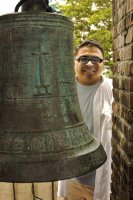 Anyway, we were disappointed when we saw the belfry since there was a big tarpaulin streamer covering the structure just like in Alcala. We were saying that the priest should have placed the streamer in front of the construction rather than on the belfry. I hope Fr. Camilo Castillejo removes his billboard from the belfry which is on the side of the oldest bell which dates back to 1595.
Anyway, we were disappointed when we saw the belfry since there was a big tarpaulin streamer covering the structure just like in Alcala. We were saying that the priest should have placed the streamer in front of the construction rather than on the belfry. I hope Fr. Camilo Castillejo removes his billboard from the belfry which is on the side of the oldest bell which dates back to 1595.That was the end of our morning itinerary and it was time to move back to Tuguegarao. Again, if we weren't pressed for time, I would have wanted to visit the next town which was Aparri and find out for myself what this town, made famous by the Eat Bulaga jingle, is all about. Hehe!
We stopped by Alcala again to buy some milk candies made from carabao's milk. These flat candies are Alcala's version of the pastillas. Along the way, I think it was in Iguig, we also bought corn from vendors along the highway.
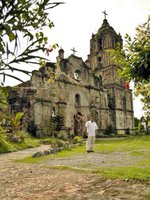 Back at the hotel, we packed our stuff and went down for a quick lunch before checking out. From there, it was a long drive to Isabela along the old highway to the town of San Pablo where ruins of an old church could be found. What is peculiar about this church is its size since it is unusually large for the community it currently serves.
Back at the hotel, we packed our stuff and went down for a quick lunch before checking out. From there, it was a long drive to Isabela along the old highway to the town of San Pablo where ruins of an old church could be found. What is peculiar about this church is its size since it is unusually large for the community it currently serves.According to accounts, San Pablo was a very prosperous town before which explains the large church. But as the years passed, people left and fortunes changed. And the church as well as other structures were left to decay. Today, only half the church is in use, having been covered by a makeshift roof and walls. It would just be too costly to restore the church entirely. But from the intricate brick designs, one could imagine its past grandeur as a center of life in Isabela.
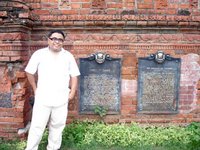 From there, we went further south to Tumauini to visit the Church of San Matias, a national cultural treasure. Just like the Callao Caves, this was another famous image in books. And finally, I got to see it for myself. I was not disappointed.
From there, we went further south to Tumauini to visit the Church of San Matias, a national cultural treasure. Just like the Callao Caves, this was another famous image in books. And finally, I got to see it for myself. I was not disappointed.The facade is said to be Pampanga's greatest contribution to Cagayan Valley heritage since it is said that Kapampangan woodcarvers were imported to create the moulds for the intricate and ornate brick tiles that adorned Tumauini and many other churches in the Cagayan Valley.
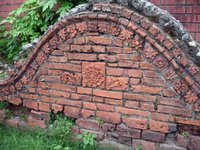 It's a pity Pampanga did not have an abundance of bricks because Tumauini was just breathtaking, each brick carefully planned and numbered to create this mosaic of ornate clay tiles.
It's a pity Pampanga did not have an abundance of bricks because Tumauini was just breathtaking, each brick carefully planned and numbered to create this mosaic of ornate clay tiles.Even the walls that surrounded the church plaza was generously decorated with designed brick tiles! Indeed, Tumauini deserves its declaration as a national cultural treasure.
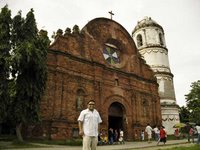 Another unique feature is the cylindrical belfry which is designed like a wedding cake. It's the only cylindrical belfry left in the country today, the other one in Leyte having been demolished by you know who. Sigh! I wonder why Tumauini, and many other deserving churches, weren't included in the original UNESCO declaration which sadly only includes Augustinian churches. Hope they make it to the expansion.
Another unique feature is the cylindrical belfry which is designed like a wedding cake. It's the only cylindrical belfry left in the country today, the other one in Leyte having been demolished by you know who. Sigh! I wonder why Tumauini, and many other deserving churches, weren't included in the original UNESCO declaration which sadly only includes Augustinian churches. Hope they make it to the expansion. Anyway, from there, it was off to Cauayan again for dinner at the Jambalaya Grill. But we stopped over in the provincial capital Ilagan to check out the biggest butaca or armchair which is on display along the national highway. After some fun shots on the giant wooden chair, we left for Cauayan.
Anyway, from there, it was off to Cauayan again for dinner at the Jambalaya Grill. But we stopped over in the provincial capital Ilagan to check out the biggest butaca or armchair which is on display along the national highway. After some fun shots on the giant wooden chair, we left for Cauayan.We were there at about 5:30 p.m. just in time for early dinner. After dinner, Jojo made a synthesis lecture of the learnings from the past two days. Then it was off to Manila at about 7:30 p.m. We made a number of stopovers to make sure the drivers were awake. And one of them was near Balete Pass where I bought some perantes, the citrus fruit of Nueva Vizcaya. Although the best place to buy them is along the highway somewhere near Bambang if I'm not mistaken. We arrived in U.P. at about 5 a.m. Lucky for the students, classes were suspended in anticipation of the heavy traffic due to today's SONA. So I'm sure everyone went straight to bed. Hehe!
The rest of the photos are at http://photos.yahoo.com/ivanhenares and http://ivanhenares.multiply.com/photos as well as in Karlo de Leon's blog.
